Ron Ludekens
Ladyfinger Grape - Olivet Blanche
Question: I just purchased a Ladyfinger grape from your nursery and was wondering if it is a seedless or a seeded variety. On the blue tag attached to the vine is the following information: 1351053 Ladyfinger (Olivet Blanche) Grapes
Thank you.
Richard
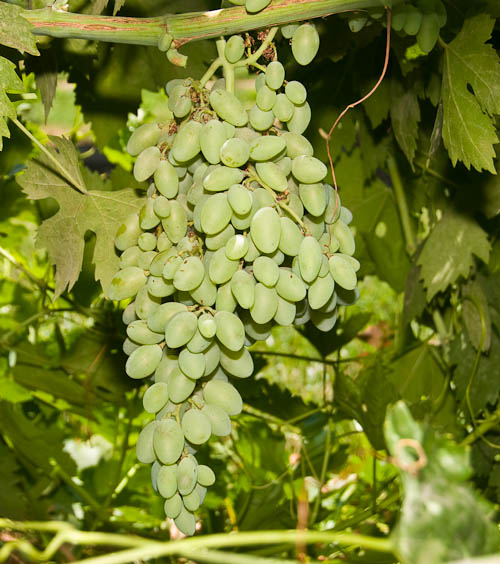
Ladyfinger Grape - Olivet Blanche
Answer: Richard,
Contrary to a lot of mail order websites, Ladyfinger Grape is seeded - not seedless. We have two selections: Calmeria & Olivet Blanche. We are slowly switching our production over to the Olivet Blanche selection which I have found to be more productive, larger and tastier. We only shipped a few Olivet Blanche this year (not even in the catalog yet) as those were more than we needed for our increase cutting block we are planting. So you have been lucky to get that selection. Enjoy.
Ron Ludekens 2-24-2010
Pomegranates in Zone 7
Question: are there any edible pomegranate varieties that will survive a zone 7? Tair Arnold, MD
Answer: Tair,
All the popular pomegranates (Angel Red®, Wonderful, Grenada, Sweet, White and even Utah Sweet) are cold hardy to U.S.D.A. Zone 9 and maybe Utah Sweet into Zone 8B. Even in Zone 9, I have seen whole commercial crops lost with an untimely spring frost and some plants killed by it. I suspect the tops are hardier but once the new spring growth comes out and gets killed back by the frost, the plants seem to have a hard time recovering.
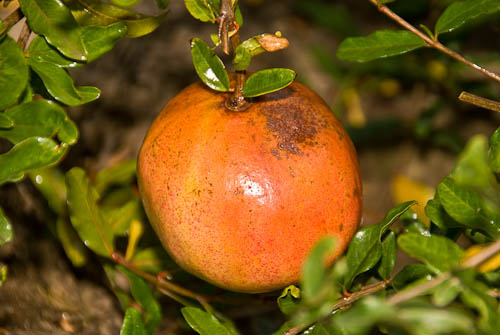
Utah Sweet Pomegranate
I'll bet the answer to your question is "Yes". There a lot more pomegranates in the world than the popular ones you see in the supermarkets (over 1000 varieties according to some sources). Some I have read are cold hardy - but I have no experience with these other pomegranates or how they taste and thus cannot provide a recommendation. There are some people in your region who grow pomegranates in large containers and move the containers into a safe place during the colder months. Ron L.
Desert Gold Peach
Question: I am thinking of buying a Desert Gold Peach tree and planting on the north side of my home. I have a plum, lime and grapefruit on this side, all which bear fruit. However it does not get much direct sun. 1-2 hours winter, 2-3 hours spring and fall, 4 hours in summer. Is this enough sun for this tree to produce? Bob
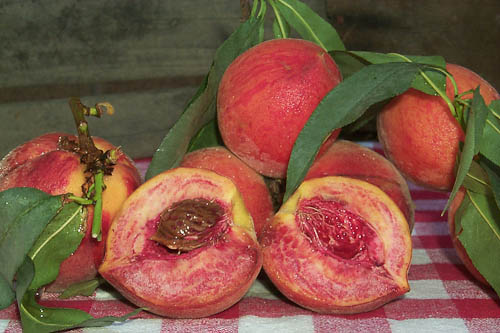
Desert Gold Peach
Answer: Bob,
Usually I like to plant my fruit trees in full sun or at least for the majority of the day. That is where the commercial orchards are for best performance. That being said, I suspect your Desert Gold Peach should do OK where you propose it. Since you have the Desert Gold Peach, I am assuming you are in a hotter desert-like climate which helps.
During the winter, the tree is dormant and does not need the sun or warmth so the 1-2 hours does not concern me. The Desert Gold Peach has an early ripening fruit - normally Late April to Mid May in southwest desert regions. Your lack of sun might cause the ripening to be later by up to a few weeks but the early fruiting and low chill requirements work in your favor. If you asked this question about a late season fruit, I would worry about not having a long enough season due to lack of sunlight. I have a genetic dwarf Golden Glory Peach on the east side of my house next to the fence in a small yard. It doesn't get over 2 hours of direct overhead light each day and it has done fine for me. Enjoy them. Ron L.
Recommended Fruit Trees for San Fernando Valley
Question: Please tell what fruit trees (especially apricots, plums, figs) you recommend for the (hot) San Fernando Valley in Los Angeles. I'd like a grape that will grow over an arbor, as well as all sorts of edible fruit.
Many Thanks, Rafael
Answer: Rafael,
Thank you for a wonderful question. I chuckle at the relative term "hot" in your question. Our growing fields, in the richest agricultural area in the world (San Joaquin Valley), is much hotter than what you experience. Heat is often a friend to fruit trees - how much winter chilling is the more important question for you and your location. Fortunately, San Fernando Valley has a good climate for a wide selection of different fruit trees. We have put together 2 pages of recommended fruit trees for the San Fernando Valley based upon what we think tastes great and would sell well at local retail nurseries. You can see this list here: San Gabriel - San Fernando Valley. Our goal is a satisfied customer who points his or her friends back to the local retail nursery that provides good tasting fruit that actually performs well for your climate. Hope this list helps in making your selections. Enjoy!
Elberta Peach Substitution for Mild Winter Areas
Question: My customer wants a Elberta Peach Tree but we don't have the correct amount of chill time, what do you suggest instead???? Leslie from Torrance CA
Answer: Leslie,
You are right - Elberta Peaches, which is nearly every one's favorite, take about 800 hours of dormant season chilling below 45º F. This prevents if from fruiting in mild winter areas like yours in Southern California. Torrance is lucky to reach 200-300 hours chilling since you are so close to the moderating influence of the ocean (limits fruit but the weather and beaches give its own perks!).
My favorite Elberta-like peach for Southern California areas is the Santa Barbara Peach (about 300 hours chilling). Actually, it is my favorite peach period. In Visalia, it fruits around the 4th of July (another reason to celebrate the date). Santa Barbara Peach possesses a beautiful cross between a sweet peach and a full flavored, acidic peach. It is soft, dripping with sweetness like a white fleshed peach, but has yellow flesh full of bold peach flavor. Its softness prevents it from being a commercial peach since it will not hold up to rigours of shipping. Likewise, it also has a short shelf life similar to white peaches. It is ideal picked fresh ripe off the tree. If you like sweet and flavor combined, this is one to seriously consider.
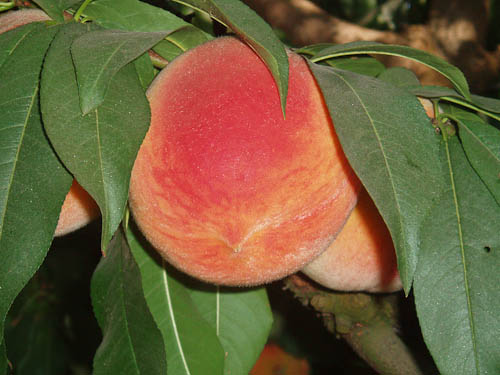
Santa Barbara Peach
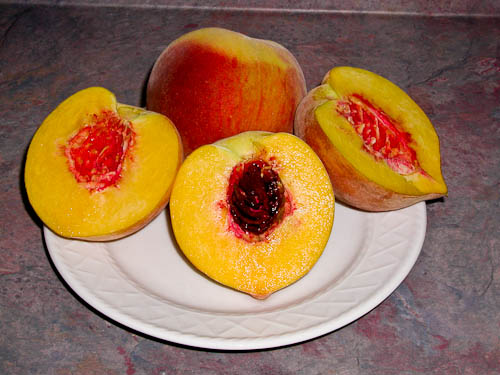
On given years you still may not make enough chilling hours at your location for the Santa Barbara Peach. Other peaches that will fruit most years in your area are: Bonita (250 hours), Earligrande (250 hours), Early Amber (250 hours), Flordaprince (150 hours), Long Beach Peach (200 hours), Tropic Snow (White - 200 hours), Red Baron (Red flowering too, 250 hours) and Saturn (Pink flowering too, 250 hours). You can see descriptions of these here: Peach Pages
Ron L.
Persian Laceleaf Lilac - Hot Climates
Question: I bought a Persian Laceleaf lilac for my yard. I was going to plant it on the east side where it would get only late morning sun and early afternoon soon. Now I am thinking about the back yard where it would get full sun all year but with the temps climbing as high as 115 in the summer I am wondering if it will be too much burning sun. My roses seem to survive but many of them were grown as root stock in the valley. Which would be the best spot for the lilac? I do want it to get enough sun to bloom but so much that it will burn and die.
Thank you for your help. Linda
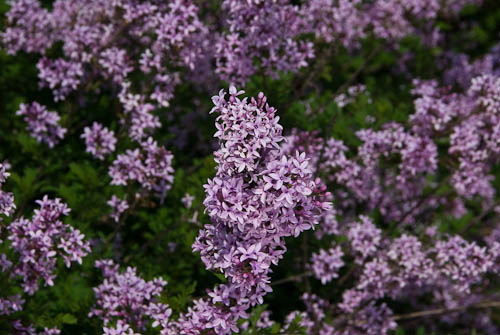
Persian Laceleaf Lilac (Syringa lacianata) Spring Blooms
Answer: Linda,
Good selection! I love the Persian Laceleaf Lilac. Have 5 in my own back yard along the fence. I really like that fern-like, soft looking foliage.
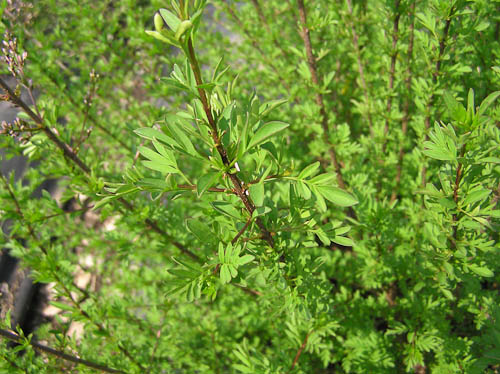
Soft Appearing Foliage all Summer Long
Two are in full afternoon sun and 3 are partially shaded and all are thriving.
Visalia gets toasty too but not quite like Phoenix. We usually see summer temperatures of 100 to 105 degrees F and up and over 110 for a week or two sometimes. Not your 115 (hurts just thinking about it). All our lilacs grow in full sun in our fields here with no problem. The Persian Laceleaf is a recommended variety for Phoenix and similar locations because it does tolerate heat.
With that said, I cannot claim to be your local expert as I have not seen the effects of 115 degree, dry heat. I'll bet some of your local nurserymen can answer that with more assurance than I can because we have been shipping this lilac to Phoenix for years. A call to Phoenix Nursery, Baker Nursery or Berridge Nursery will likely find a person who has seen the performance of the lilac in full sun. Since I do not know, I might plant it where the afternoon sun might be shaded a bit, but still have full morning sun. Ron L.
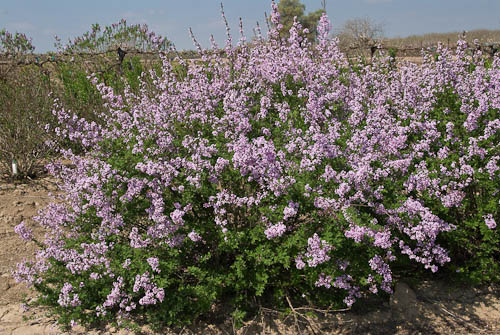
Spring Photo of Persian Laceleaf Lilac (Syringa lacianata)
Flowering Quince
Question: How to make the quince blooming in Chinese new year!!
Shuna
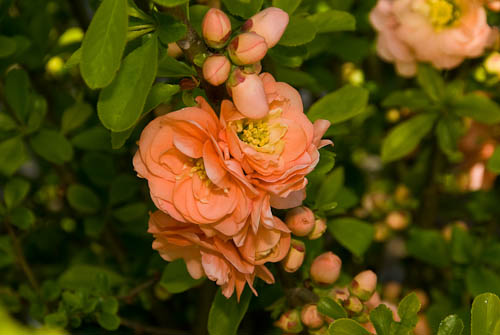
Answer:Shuna,
I love the Flowering Quince (Chaenomeles speciosa) as a cut flower! When everything else in your garden is still dormant, these hardy plants make their welcomed early arrival with a burst of color. These plants are one of the first to bloom and, as such, are popular for the Chinese New Year.
Of course the answer to your question depends a lot on where you live (climate) in relation to when Chinese New Years falls.
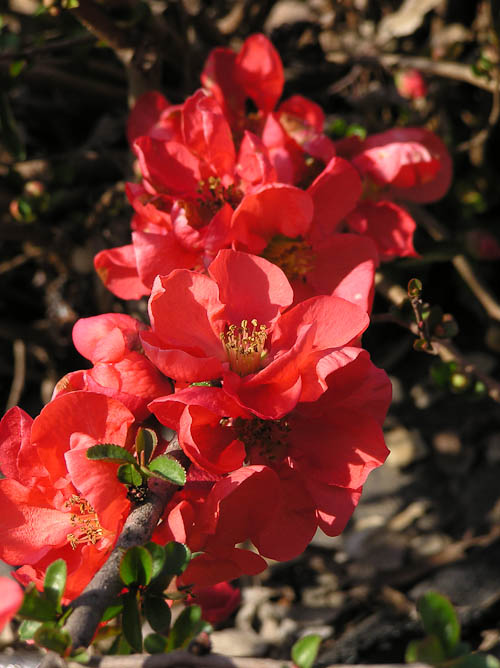
Flowering Quince blooms on last year's growth. After the bloom each spring, cut back the plant. Then the rest of the year will grow branches which will bloom the following spring. A dormant branch can be brought indoors where it is warmer and will bloom over time. I usually like to cut mine when the buds are already starting to swell or even blooming at the tips. I confess that I am not a cut flower grower and have not created a recipe of how early to cut it or how warm to set a room to reach peak bloom. I think you will have to do some experimenting or contact a cut flower expert if you want to do this in any commercial quantity.
The Flowering Quince also are quite attractive to birds.
Follow this link to information about different varieties of Flowering Quince: Flowering Quince
Ron L.
Multiple Trees in the Space of One
Question: Do your bareroot plum and peach trees have the same rootstock? If not, are the rootstocks for these trees compatible with one another if I were to plant them together in the same hole? Thank you. James
Answer: James,
Most plums are on plum rootstock (Myrobolan, Mariana, Citation, etc). The peaches are on peach rootstock (Nemaguard, Lovell, Siberian, etc.). Exact rootstock is of course dependent upon the specific variety and whether standard or semi-dwarf.
Not to worry though. Compatability is only a concern if you are trying to bud multiple varieties on the same rootstock. What you want to do is exactly what we recommend. In the space of one tree, you can plant several trees and there is no compatibility concerns unless one tree grows so much larger than the order to shade it out. Here is a page on our website with more information about multiple trees in the space of one: Multiple Trees in the Space of One
Maybe you might want to add even another! Enjoy your future fruit.
Point of Sale Application Ideas
Tim, owner of Old Towne Nursery in Tehachapi, CA, shared with us the way he uses the Point of Sale pages to help sell his trees. He uses the large wooden fruit bins for holding the trees and attaches the laminated pages to the bins.
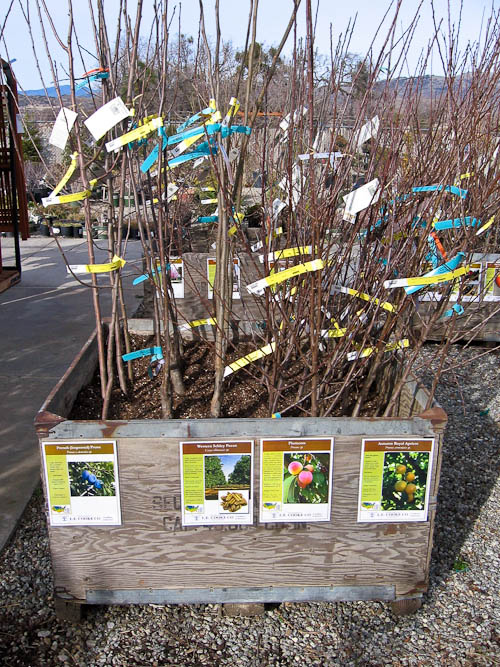
For a relatively small community, Tim's nursery blows through a lot of trees each spring.
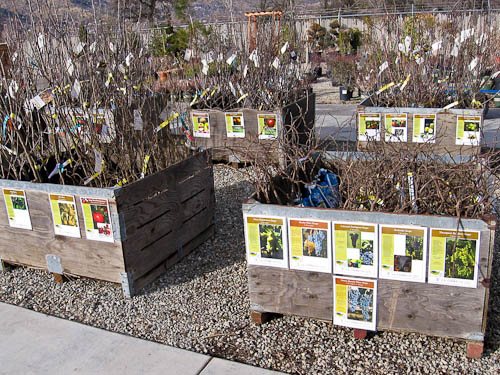
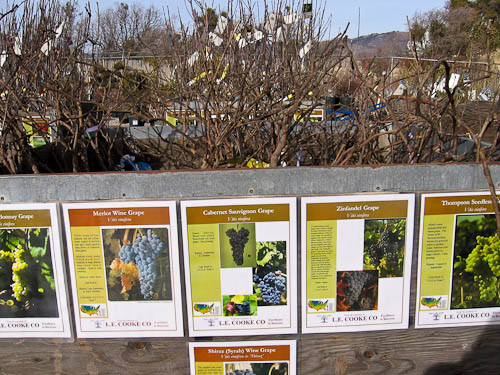
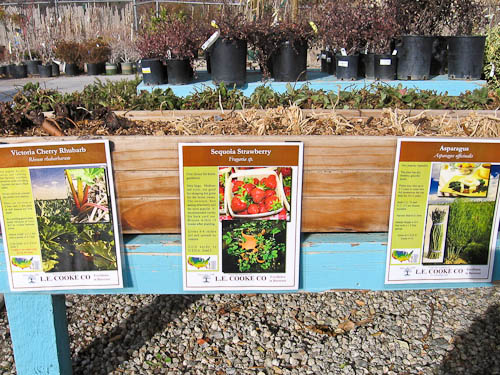
Tim, thank you for sharing your photos and ideas with all of us.
Point Of Sale Information Pages
I am always amazed at the vast amount of knowledge every retail nursery person maintains in their heads. I have a hard time remembering all the details about our own products - to know the details of the thousands of other products is mind boggling.
But even if you know it all, you cannot always be available to answer every customer's question. You need the silent helpers in the form of Point of Sale signs.
We have created hundreds of POS Information Pages with hundreds more in work (as I have time). (See samples here)
These are 8 1/2" x 11" pages with large color photos and written descriptions designed to sell your trees. They are free to our customers to download and print from our web site. They work great printed on paper and then laminated or can also be printed on special waterproof LaserTag stock. Some customers also print them for counter books and inside displays.
We also can print the POS pages for you for a nominal charge and optionally laminate them. Costs for these services are printed in the sales aids section of our catalog.
If we do not have a finished page, ask us and I'll make it my next priority assuming I have the photo(s) in my collection.
We will announce via Twitter as each new page is posted or revised. Since many of you use these pages, follow us on Twitter and keep abreast of the latest postings.
Here are links to show how nurseries around the country are using these pages:
Please share your own ideas with others. Email photos to me and I will post them on this idea blog.
Thank you
Ron Ludekens

